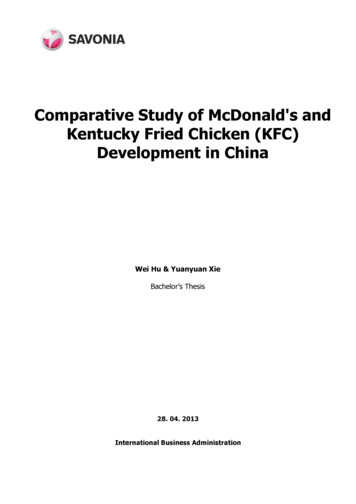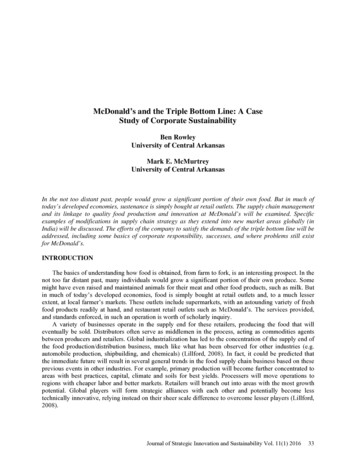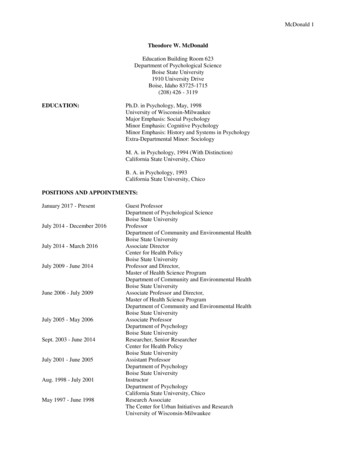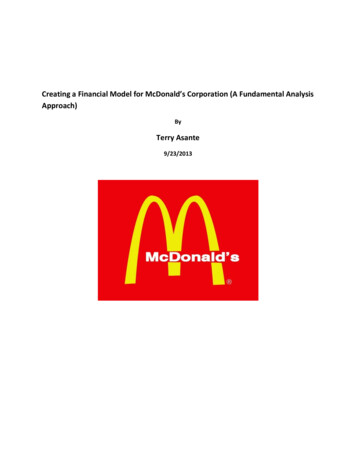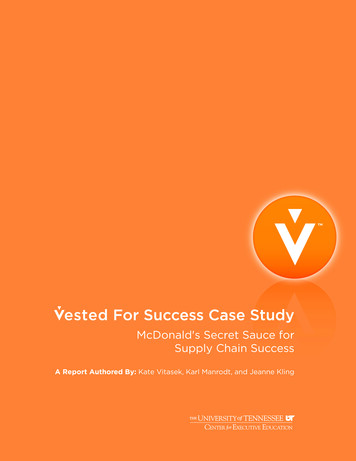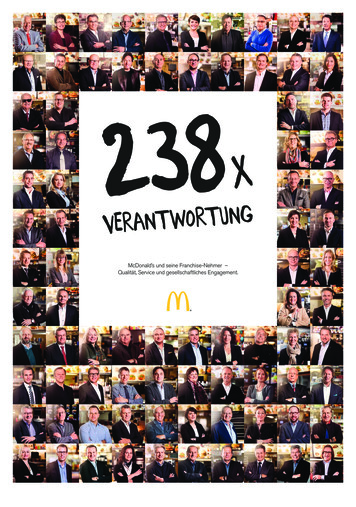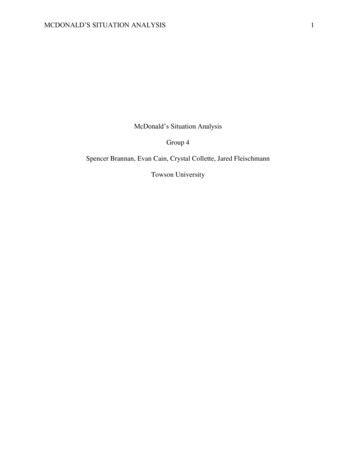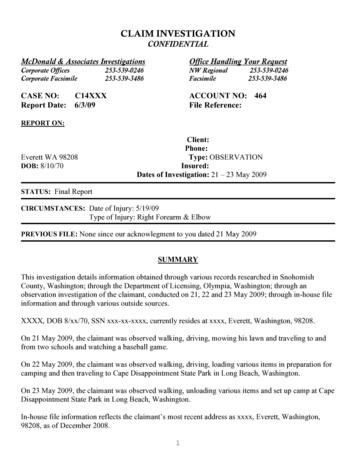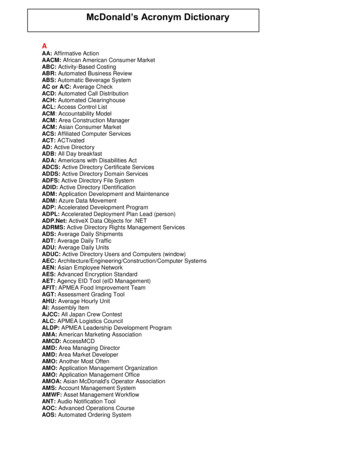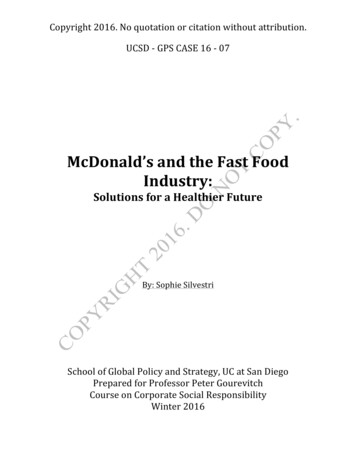
Transcription
Copyright 2016. No quotation or citation without attribution.UCSD - GPS CASE 16 - 07McDonald’s and the Fast FoodIndustry:Solutions for a Healthier FutureBy: Sophie SilvestriSchool of Global Policy and Strategy, UC at San DiegoPrepared for Professor Peter GourevitchCourse on Corporate Social ResponsibilityWinter 2016
Copyright 2016. No quotation or citation without attribution.EXECUTIVE SUMMARY:Silvestri Solutions Inc. has been hired by the American Diabetes Association to respondto the issue of growing childhood and minority obesity and health risks—like Type 2 Diabetes—and develop a Corporate Social Responsibility (CSR) agenda with strategies to improve healthyoptions at McDonald’s and similar fast food chains. McDonald’s targets advertising to childrenand minority groups,1 which are vulnerable populations due to a greater lack of knowledge thanmore affluent, white populations on the following: food portions, caloric intake and importantrationing of certain ingredients. Medical Journals like American Journal of Managed Careconsider vulnerable populations “the economically disadvantaged, racial and ethnic minorities,the uninsured, low-income, children, the elderly ” among others. 2 Even with growingawareness of obesity and Type 2 Diabetes, cases of the two continue to rise and are inextricablylinked. McDonald’s is a mega corporation and profit maker from its sales of unhealthy food; itreported profits of 1.31 billion in 2015,3 and their revenue sources are mainly food sales,franchise fees, rents and royalties.McDonald’s is contained by their shareholders, executive management and by themarket; their leadership focuses on profit-driven initiatives and their market desires affordableand convenient food items. However, Silvestri Solutions, Inc., on behalf of the AmericanDiabetes Association, has warned executive management at McDonald’s multiple times aboutthe pressure point of obesity—an issue that continues to be addressed at the federal, state andlocal levels. McDonald’s has made some attempts to combat obesity, like substituting apples forFrench fries and milk for soda in “Happy Meals,” but as the leading fast food chain in the U.S.,4more needs to be done. Fast Food restaurants, although not the sole cause of the obesity crisis inthe U.S., are very responsible for its growing rates. In the sections of this report that follow,
Copyright 2016. No quotation or citation without attribution.Silvestri Solutions Inc. will review two Scenarios for American Diabetes Association’sconsideration: Scenario 1 presents voluntary programs American Diabetes Association canpresent to McDonald’s. Scenario 2 (the recommend the Scenario) is a plan of action forlegislation starting in the State of California to require McDonald’s and other fast food chains toreduce unhealthy ingredients from menu items. The two Scenarios are outlined in this sectionand discussed in detail in the sections that follow.American Diabetes Association has a professional relationship with McDonalds, asMcDonalds has sponsored some of its events and programs in the past;5 therefore, there iscommunication despite American Diabetes Association’s frustration with many of McDonald’sunhealthy menu items. Scenario 1 initiatives are threefold: recreating the marketing relationshipwith McDonald’s, promoting healthier options to be included in government assisted foodprograms, including health warnings on television advertisements and including physical activityin the television advertisements to promote healthy living in commercials, working with federalagencies and the company’s marketing department, respectively. However, because legislationcould apply sanctions or injunctions on the fast food industry led by McDonalds, a differentstrategy is recommended.Scenario 2, the recommended strategy, is to address the issues from a Californiastatewide perspective and having American Diabetes Association sponsor legislation in the Stateof California, regulating the fast food industry on levels of allowable ingredients. AmericanDiabetes Association’s nonprofit has a good reputation as well as a strong and dedicatedfollowing. This legislation can use McDonald’s negative impact on obesity as an example butaugment the effectiveness of a “Stop Diabetes” campaign by including other fast food chains inthe legislation. In order to carry out these initiatives, Silvestri Solutions, Inc. recommends
Copyright 2016. No quotation or citation without attribution.American Diabetes Association propose this legislation to the office of CaliforniaAssemblywoman Toni Atkins (House Speaker until March 10, 2016) before November 2016because she is termed-out. This report includes the process to lobby for this legislation to reachthe California State Senate and ultimately be signed into law by California Governor JerryBrown. As referenced previously, McDonald’s sponsored American Diabetes Association’sevents in the past, but none recently. Therefore, Silvestri Solutions, Inc. understands there is noallegiance or potential loss of current sponsorship that would cause concern by pursuinglegislation.BACKGROUND:As American Diabetes Association is aware, the U.S. Department of Health and HumanServices’ Office of Minority Health reports staggering numbers among minorities and childhoodoverweight and obesity rates. One is considered overweight with a body mass index (“BMI”) of25 or higher, and obese with a BMI of 30 or higher. African Americans are the population withthe highest risk for obesity, especially African American women—approximately four out of fiveAfrican American women are overweight or obese.6 Table 1 displays statistics for male andfemale populations over 20 years of age that are obese or overweight, based on race. Table 2Adisplays statistics for male and female children who are overweight and Table 2B displaysstatistics for all children (both male and female) who are obese, based on race. These statisticswill be helpful for the public to understand why the legislation is necessary to stop obesity inorder to “Stop Diabetes.”
Copyright 2016. No quotation or citation without attribution.Table 1: Male and Female Populations over 20 (Obese or Overweight) based on cWhite73.6%60.3%Non-Hispanic Black/ Non-HispanicWhite Ratio1.01.3Source: CDC, 2013. Table 68.http://www.cdc.gov/nchs/data/hus/hus12.pdfTable 2A: Male and Female Children who are HispanicWhite14.0%18.6%Non-Hispanic Black/ Non-Hispanic WhiteRatio1.81.3Source: CDC, 2013. Table 69.http://www.cdc.gov/nchs/data/hus/hus12.pdfTable 2B: All children who are Obese, Based on RaceAfrican American Non-Hispanic White African American/ Non-Hispanic White Ratio25.7%14.6%1.8Source: Federal Interagency Forum on Child and Family Statistics. America's Children: KeyNational Indicators of well being. 2013. Table tables/health7.aspType 2 Diabetes Linked to Fast Food:It is important for Silvestri Solutions, Inc. to reiterate statistics and information on healthrisks, as they valuable for Scenario 1 and especially for Scenario 2. They will serve asbackground for proposed state legislation and support letters so the public can more easilyunderstand the linkage between fast food, obesity and thus, Type 2 Diabetes. Fast food, likeMcDonald’s, has benefits, including convenience and cheap prices. However, the health risks
Copyright 2016. No quotation or citation without attribution.overwhelm the benefits. By eating fast food regularly—which is usually high in sodium, fats,sugar, carbohydrates and calories—fast food patrons have the tendency to gain weight to thepoint of obesity.Silvestri Solutions must communicate why obesity is predominantly caused by unhealthyintake and lack of exercise, and these are leading causes of Type 2 Diabetes. At very heavyweights, one’s body cannot produce enough insulin for all the weight to take glucose out of theblood. Thus, this overtasks the pancreas, and overtime, a person who is obese or overweightbecomes insulin resistant, or a Type 2 Diabetic.7 Type 2 Diabetes is the most common form ofdiabetes,8 effecting nearly 29 million people in the U.S., according to the Center for DiseaseControl, and roughly 86 million considered “pre-diabetic” or at risk for Type 2 Diabetes.9 Of the29 million Type 2 Diabetics, approximately 4 million are Californians.10 These statistics can beeasily found on American Diabetes Association’s website and should be reiterated so moremembers of the public understand. Additionally, the potential legislation would drive moremembers of the public to research and discover facts about more risks and causes of Diabetes.Containment by shareholders and the market:McDonald’s is a publicly traded company (NYSE: MCD) and with 1,576 differentinstitutions holding shares and some individuals holding up to 87,500 shares, 11 there issignificant pressure for marketing efforts, like television commercials, that will drive profits andtherefore dividends to shareholders. Additionally, much of the targeted audience is low incomeor under-informed populations and chooses McDonald’s as an affordable and convenient mealoutlet.12 For this reason and others that follow, Scenario 1 has a higher likelihood of stalemateand ineffectiveness because it is not binding; McDonald’s could see these measures as more
Copyright 2016. No quotation or citation without attribution.goal-oriented and will likely use this partnership with American Diabetes Association as a publicrelations piece to boost their ever-volatile image in the media and public.Field of social concern involving corporate behavior: ads to children and minoritiesMcDonald’s disproportionately targets their advertising to children.13Currently,advertising is accused of being a factor in causing children's obesity, which contributes greatly toType 2 Diabetes; McDonalds is continuously accused of manipulating children to makeunhealthy decisions with nutrition, as they are not aware of its consequences. 14 Children underthe age of 12 make up a market that is estimated to represent 500 billion, consisting of personalspending of 200 billion that includes snacks and soft drinks and 300 billion of indirectspending on food, among other items.15 The world’s second largest employer insists nutrition isthe responsibility of parents, not fast food companies like themselves. 16 The fast food industryspends several billion dollars on advertising annually. Each day, the average preschooler, olderchild, and teen views 2.8, 3.5, and 4.7 television ads, respectively. McDonalds is responsible for25% of these advertisements. 17Additionally, McDonalds disproportionately targets minorities, specifically AfricanAmericans, and it is not a new trend; in fact, it is more than 30 years in the making. In 2010alone, McDonald’s television advertisements featured 50% all African American casts andchannels watched more by African Americans like daytime court TV have more of theseadvertisements.18 In a study presented by the Rudd Center, commercials that feature healthiersnacks, like yogurt, are less likely to be seen on channels that have large Latino and AfricanAmerican viewership.19 McDonald’s has a website dedicated to promoting African Americanculture, called 365Black.20 Dr. Imani Perry, from Princeton University’s Center for AfricanAmerican studies spoke of the stereotypes:
Copyright 2016. No quotation or citation without attribution.“McDonald’s direct marketing to African Americans has always troubled me, largelybecause so many African Americans live in urban areas surrounded by fast foodrestaurants and with limited access to fresh produce and unprocessed food. It seemed toadd insult to injury to present this business as having any investment or interest inAfrican American history and culture.”The image to the left is an example ofadvertising to African Americans in the1970s. (Image n-70sadvertising/394958/. Retrieved 11 March2016).These vulnerable groups tend to have less information on healthy diets than educated,affluent groups. McDonald’s is not the only fast food chain that targets these populations, but asit is the corporate giant of fast food, their decision makers have an opportunity to lead the effort.According to the Fast Food F.A.C.T.S. (Food Advertising to Children and Teens Source),McDonald’s scores very low on the healthy kids’ menu list at fast food chains, scoring at a low38, 41 and 42 out of 49 fast food healthy kids’ menu options; Arby’s Burger King, Subway,
Copyright 2016. No quotation or citation without attribution.Sonic, Jack-in-the-Box and Chick-Fil-A scored higher.21 As the largest fast food chain in theworld, according to Forbes, McDonald’s can do better.22 F.A.C.T.S. rates kids’ meals by theNutrition Profiling Index (NPI), which scores an overall nutritional quality based on calories, andvariance of healthy and unhealthy ingredients including sodium and saturated fat, as defined bythe National Center for Biotechnology Information.23 A snapshot chart of fast food chainsscoring 19-40 in the list of NPI kids meal ratings is shown below in table 3:Table 3:KIDS MEALS AT FAST FOOD RESTAURANTSNPI: SORTED BY AVERAGE SCORE OF MAIN DISH, SIDE DISH, BEVERAGEAND SNACK/DESSERT:MAINSIDERANK RESTAURANTDISHDISHBEVERAGE DESSERT19 JACK IN THE BOX68707020 BURGER KING64787021 BURGER KING64787022 SUBWAY72827623 SUBWAY72827224 SUBWAY78827225 ARBY'S66687026 BURGER KING64787027 CHICK-FIL-A60787228 CHICK-FIL-A42787229 JACK IN THE BOX68707030 ARBY'S50787231 ARBY'S50787232 SONIC48827233 BURGER KING64787234 SONIC44827235 BURGER KING50787236 KFC6278703637 WENDY'S46807238 MCDONALD'S44787239 CHICK-FIL-A50787240 KFC62867036
Copyright 2016. No quotation or citation without g/media/fastfoodfac
linked. McDonald’s is a mega corporation and profit maker from its sales of unhealthy food; it reported profits of 1.31 billion in 2015,3 and their revenue sources are mainly food sales, franchise fees, rents and royalties. McDonald’s is contained by their shareholders, executive management and by theFile Size: 1MBPage Count: 22
